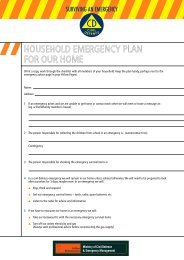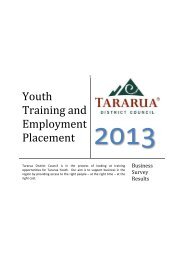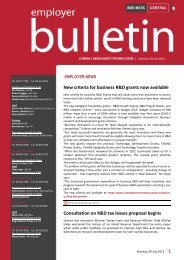Food Control Plan Checklist - Tararua District Council
Food Control Plan Checklist - Tararua District Council
Food Control Plan Checklist - Tararua District Council
- No tags were found...
Create successful ePaper yourself
Turn your PDF publications into a flip-book with our unique Google optimized e-Paper software.
Serve SafeDisplay and self-service1 Goal 2 Why?To display and serve food in a manner that minimises the riskof contamination and the growth of harmful microbes.To reduce the amount of time prepared readily perishable foodis held in the temperature danger zone (4ºC to 60ºC).• <strong>Food</strong> in the temperature danger zone (4ºC to 60ºC) willencourage harmful microbes to grow rapidly.• Poor arrangement of food can lead to contamination whencustomers reach across displays.• Self-service displays present a high risk because manypeople have access to the food.3 How this is doneHot food• When reheating food the instructions in the Reheatingprepared food procedure are followed.• When hot-holding food the instructions in the Hot holdingprepared food procedure are followed.Chilled food• Ready-to-eat, readily perishable foods are held at 4ºC orbelow unless on display no longer the four hours.• The time ready-to-eat food is left on display above 4ºC isindicated by [tick method used]:time written on stickers stuck on wrapping or next tothe foodcoloured stickers stuck on wrapping or next to the foodotherDisplay/serving• <strong>Food</strong> is put out for display/service as soon as possible afterpreparation.• Clean serving utensils are provided for each food item ordish, and handles do not touch the food.• <strong>Food</strong> is protected from contamination by the use of:[tick method used]sneeze guardscovers over foodother<strong>Food</strong> on display is not topped up with, or mixedwith fresh batches.• When food displays (eg, unwrapped food such as salads,hot foods etc) need more food they are replaced withcompletely new batches of food.• Left-over self-service food is not reused (eg, it is not carriedover to the next day).• Serving spoons are replaced whenever they have beenmisused, or could otherwise have become contaminated.• Single use items are thrown away after use (eg, paperplates, cups, plastic cutlery etc).• Self-service displays are appropriately supervised.4 What if there is a problem?Replace food and/or serving utensils that could have becomecontaminated through poor food handling practices, ormisuse.Throw away any food that could have been contaminated bycustomers or others.Hot foodIf hot food has been held at less than 60ºC, but higher than21ºC for more than two hours it must be thrown away.• If hot food has been held at a temperature below 60ºC fortwo hours or less, it can either be:• thoroughly reheated and served hot (above 60ºC), or• cooled to 4ºC within four hours and kept at thistemperature until it’s eaten.Chilled foodReady-to-eat readily perishable food that has been attemperatures between 4ºC and 60ºC:• for a total of less than 2hrs must be refrigerated or usedimmediately, or• for a total of between 2 and 4hrs must be usedimmediately, or• for a total of 4 hours or longer must be thrown out.5Write it downWrite down in the Diary any problems thatyou’ve had keeping food at the correcttemperature and what action you took tofix it.Make a note in the Diary of any items thatyou have had to throw away, and why.Also write down any matters that needfollow up (eg, training, review cleaningschedule etc).<strong>Food</strong> <strong>Control</strong> <strong>Plan</strong> Version 3.0 2011S14







